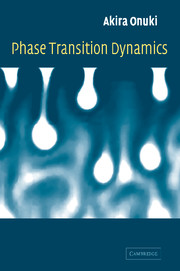10 - Phase transition dynamics in solids
Published online by Cambridge University Press: 13 August 2009
Summary
A variety of domain structures have been observed in metals undergoing (i) phase separation, or (ii) structural phase transitions [1]–[6]. In phase separation, a difference arises in the lattice constants of the two phases (lattice misfit). At a structural phase transition, anisotropically deformed domains of a stable low-temperature phase emerge in a quenched, metastable or unstable high-temperature phase. As a consequence, elastic strains are induced which radically influence the phase transition behavior. Here we will present Ginzburg–Landau theories for phenomena (i) and (ii) under the coherent condition [1], in which the lattice planes are continuous through the interface without any coherency loss due to dislocations, as illustrated in Fig. 10.1(a). In the incoherent case, however, dislocations are accumulated at the interface regions, and the resultant elastic effects have not yet been well investigated.
Among a number of important topics, here we cite examples of research on phase separation in binary alloys. In particular, experiments on Ni-base alloys are noteworthy [7]–[16]. (i) Figure 10.2 shows Ni3Al (γ′) cuboidal domains (precipitates) with the ordered L12 structure (illustrated in Fig. 3.10) in a disordered fcc Ni–Al alloy matrix [8]. Here, initially spherical domains changed their shapes into cuboids with facets in {100} planes as they grew. (ii) As can be seen in Fig. 10.3, at a very late stage cuboids can be seen sometimes to split into two plates or eight cuboids, despite an increase in the surface energy [3], [5a], [9, 15].
- Type
- Chapter
- Information
- Phase Transition Dynamics , pp. 552 - 640Publisher: Cambridge University PressPrint publication year: 2002
- 1
- Cited by

